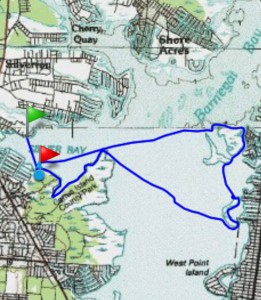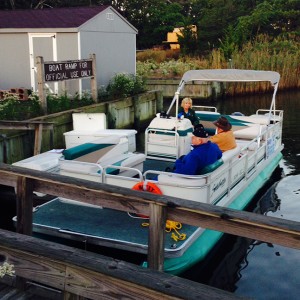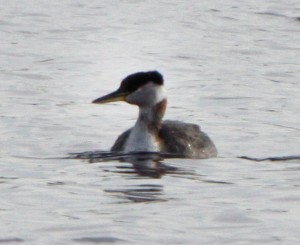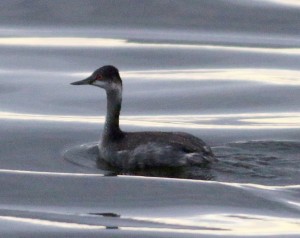Today marked the end of our 2014 season for the Barnegat Bay Birding-by-Boat tours that I have been leading for Cattus Island County Park since July, so it seems like a good time for a seasonal re-cap. We were running these trips on average every week or two, leaving from the Ocean County Parks Administration boat launch area in Toms River. Our pontoon boat (the Betty C.) holds six passengers, and we would run two trips on the days that they were offered; one at 7AM and one at 9:30AM. The trips often were filled, despite the need to pre-register through old-school methods; let’s hope that the park system gets its stuff together and will move to an improved electronic registration system by next year.
Our route typically followed the coast along the shoreline of Cattus Island Park, greeted by the resident Great Egrets, Great Blue Herons, Belted Kingfishers, Ospreys, and both Barn Swallows and Northern Rough-winged Swallows (which nest in the shoreside ‘cliffs’ at Yellowbank). Earlier in the season Marsh Wrens would call incessantly from the reeds, and occasionally we’d view some of the resident Little Blue Herons or Tricolored Herons of Cattus Island Park, or Spotted Sandpipers bobbing and feeding on the shoreline, and it was fun to watch the nesting and feeding of the Ospreys centered around their nest platforms.

Our typical route, starting and ending on the west side of Barnegat Bay at the Cattus Island County Park boat launch, crossing the bay and exploring the Sedge Islands near Lavalette.
Our route then crossed to the eastern side of Barnegat Bay, heading for the Sedge Islands offshore from Lavalette. On the journey over we’d be entertained by the diving feeding behavior of terns, which could include Common Tern, Forster’s Tern, Least Tern, and Royal Tern, all of which were seen this year. The Sedge Islands usually provided the highlight of the trips, because it is here that we find colonies of nesting wading birds, including Great Egrets, Snowy Egrets, Little Blue Herons, Tricolored Herons, Black-crowned Night-Herons, Green Herons, Glossy Ibis, and American Oystercatcher. The islands are breeding or feeding grounds or roosting sites for Tree Swallows, Barn Swallows, Purple Martins, Double-crested Cormorants, and the four common eastern Gulls (Great Black-backed, Herring, Laughing, and Ring-billed). In particular, it was fun to watch the progression of the young gulls from small downy balls hiding in the grass, to young birds begging for food from their parents, to full-sized immature birds that eventually venture out to the water by themselves.
All of these species came to be expected on our tours (although we usually saw more species and more individuals on the 7AM tours). The fun of birding often lies in the surprises, and we had a few during the season, ranging from a surprising Red-necked Grebe that stayed until June 25, a flyover mature Bald Eagle, a Yellow-crowned Night-heron on a day where we explored a different section of the bay, and a pair of Whimbrels flying by during shorebird migration. Today we ended the season with a bang, spotting a pair of small grebes feeding in the bay. The first one was seen offshore near Cattus Island, but resulted in only an unsatisfactory view before it flew off further west. Then approximately 30 minutes later I spotted a grebe again, this time on the eastern side of the bay near the Lavallette Sedge Islands. It remains possible that this was the same bird that we saw 3 miles away near Cattus, but this time I was able to get documentation photos in the overcast early morning light. Amazingly, the photos helped to identify this bird as a tough-to-find Eared Grebe. Eared Grebes are on the NJ birds review list, with only 1-2 spotted in NJ annually. My thanks to Captain Diane for her cheerful early morning smile, and I look forward to starting these trips again next season. I have made some suggestions to see if we can insert a few surprise trips into the schedule next year to further expand on the Barnegat Bay birding options and to find more species.


